The Development of Journalism in the Age of News Online
In the rapidly altering landscape of journalism, the digital age has actually ushered in a brand-new age where the immediacy of on-line information reshapes both its production and usage. As electronic platforms multiply, they improve interactivity and widen the reach of journalism, yet at the same time test typical norms with the speedy spread of info and false information alike. The rise of person journalists and independent voices additionally makes complex the narrative, adding to a dynamic yet precarious media ecological community. As we navigate these intricacies, one have to question concerning the future of journalistic integrity and exactly how it can be safeguarded in the middle of these transformative adjustments.

Increase of Digital Information Platforms
The surge of digital information platforms has basically transformed the landscape of journalism, noting a shift from standard print media to vibrant, on the internet rooms. This development was propelled by improvements in technology and the enhancing accessibility of the web, which enabled information to be disseminated quickly and broadly. Unlike their print equivalents, electronic platforms can instantaneously update material, supplying real-time information coverage and analysis that allures to the modern-day visitor's demand for immediacy and importance.
Digital platforms have likewise expanded the extent of journalism, enabling a diversification of voices and viewpoints. With reduced barriers to entrance, independent reporters and smaller wire service can reach worldwide target markets, testing the syndicate as soon as held by developed media conglomerates. This democratization of news has enhanced the general public discussion, supplying differed stories and accommodating particular niche passions that were previously underserved.
Moreover, the integration of multimedia aspects such as video, audio, and interactive graphics improves storytelling, making news much more obtainable and interesting (dw news). This multimedia come close to not just draws in a broader audience yet additionally help in the understanding of complicated stories. Essentially, digital platforms have actually redefined journalism, cultivating innovation and adaptability in an ever-evolving media atmosphere

Effect of Social Media
Social media platforms have further transformed journalism by changing exactly how news is consumed and shared. In addition, social media has actually broadened audiences, granting reporters accessibility to global viewership beyond geographical restraints.

The interactive nature of social networks fosters engagement, permitting audiences to join conversations, share viewpoints, and add to information narratives. This interaction improves the dynamic between reporters and their audiences, advertising a more participatory kind of journalism. Nonetheless, this also positions enormous pressure on reporters to produce material that reverberates with audiences, often focusing on sensationalism to capture focus.
Furthermore, social networks systems have actually ended up being important devices for journalists to resource stories, assess popular opinion, and connect with industry peers. By keeping track of trending subjects and user-generated material, reporters can discover stories that may or else be forgotten. Yet, the reliance on social media sites also demands a crucial analysis of sources to make sure the reliability of information shared. In this progressing landscape, adaptability stays critical for journalists to prosper.
Challenges of False Information
Amidst the digital revolution of journalism, one considerable difficulty is the prevalent spread of false information. In a period where details is bountiful and web rapidly accessible, differentiating in between qualified information and made web content has actually come to be significantly hard. The large quantity of details disseminated across various online platforms often obscures the line in between reality and fiction, presenting a considerable danger to the stability of journalism.
Misinformation can spread rapidly through social media, where algorithms focus on involvement over precision, accidentally intensifying incorrect stories (dw news). This not only undermines public rely on media organizations but also fosters an environment where deceptive web content can affect popular opinion and decision-making processes. The challenge for journalists is twofold: to disprove falsehoods successfully and to maintain strenuous standards of fact-checking and verification
Further complicating this concern is the existence of deepfakes and sophisticated disinformation projects that utilize advanced modern technologies to develop deceptive material indistinguishable from reputable reporting. As these modern technologies progress, so must the devices and techniques employed by journalists to battle them. Addressing misinformation calls for collaboration in between media organizations, innovation companies, and policymakers to establish comprehensive methods that safeguard the credibility of information in the electronic age.
Function of Person Journalists
Browsing the landscape of false information highlights the transformative impact of resident reporters within the digital realm. As typical media outlets face the sheer rate and quantity of news circulation online, person journalists-- average individuals equipped with smart devices and access to social networks-- are playing a significantly critical function. These grassroots factors have actually become important in covering occasions promptly, commonly providing real-time updates from the ground before mainstream media can respond.
Citizen journalists have equalized information coverage, intensifying voices that could or else continue to be unheard. By leveraging systems like Twitter, Facebook, and Instagram, they offer varied viewpoints that test the stories often pushed by established media.
Nevertheless, citizen journalism is improving the media landscape, engaging typical electrical outlets to adjust by incorporating user-generated web content right into their coverage. By promoting neighborhood interaction and encouraging participatory journalism, these electronic storytellers add to a more inclusive and dynamic news environment. As citizen journalists continue to progress, their role in shaping public discourse stays a crucial element of modern journalism.

Future of Journalistic Stability
The expansion of digital systems has democratized details circulation, allowing a wider array of voices to contribute to the news landscape. This has additionally led to the spread of misinformation and the erosion of count on in media.
The increase of fabricated knowledge and algorithm-driven material curation further makes complex the landscape. While AI can enhance coverage by evaluating vast datasets and determining trends, it additionally poses risks of prejudice and control. Reporters should for that reason remain alert, guaranteeing that modern technology serves as a device for truth as opposed to distortion.
Additionally, the monetary pressures on typical media electrical outlets require innovative organization designs to sustain top quality journalism. Subscription-based versions, nonprofit financing, and collaborations with tech firms are becoming potential remedies. Yet, they have to be gone after without compromising content independence.
Inevitably, the future of journalistic stability depends on the dedication of journalists and media organizations to promote transparency, liability, and an unfaltering like it dedication to fact, in the middle of a rapidly altering digital world.
Verdict
The development of journalism in the digital age provides both opportunities and difficulties. The rise of electronic news platforms and social media sites has equalized information circulation, encouraging a diverse variety of voices, including resident reporters. However, these innovations demand vigilant initiatives to combat misinformation and promote journalistic integrity. The future of journalism hinges on the capacity to adjust innovative service versions that sustain quality reporting while keeping the trustworthiness and count on crucial for informed public discourse.
The surge of electronic information systems has actually basically changed the landscape of journalism, noting a change from traditional print media to vibrant, on-line rooms. With reduced obstacles to entrance, independent reporters and smaller sized news organizations can reach worldwide audiences, challenging the monopoly once held by established media conglomerates.Social media systems have further revolutionized journalism by altering just how information is eaten and shared. As typical media electrical outlets grapple with the large speed and volume of news circulation online, person reporters-- normal people equipped with smart devices and accessibility to social media-- are playing a significantly essential function. The increase of digital news systems and social media has democratized Full Report details circulation, equipping a diverse array of voices, consisting of resident reporters.